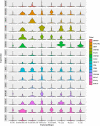Causal relationship between systemic lupus erythematosus and primary liver cirrhosis based on two-sample bidirectional Mendelian randomization and transcriptome overlap analysis
- PMID: 38167341
- PMCID: PMC10762944
- DOI: 10.1186/s13075-023-03235-z
Causal relationship between systemic lupus erythematosus and primary liver cirrhosis based on two-sample bidirectional Mendelian randomization and transcriptome overlap analysis
Abstract
Background: Overlapping cases of systemic lupus erythematosus (SLE) and primary biliary cirrhosis (PBC) are rare and have not yet been fully proven to be accidental or have a common genetic basis.
Methods: Two-sample bidirectional Mendelian randomization (MR) analysis was applied to explore the potential causal relationship between SLE and PBC. The heterogeneity and reliability of MR analysis were evaluated through Cochran's Q-test and sensitivity test, respectively. Next, transcriptome overlap analysis of SLE and PBC was performed using the Gene Expression Omnibus database to identify the potential mechanism of hub genes. Finally, based on MR analysis, the potential causal relationship between hub genes and SLE or PBC was validated again.
Results: The MR analysis results indicated that SLE and PBC were both high-risk factors for the occurrence and development of the other party. On the one hand, MR analysis had heterogeneity, and on the other hand, it also had robustness. Nine hub genes were identified through transcriptome overlap analysis, and machine learning algorithms were used to verify their high recognition efficiency for SLE patients. Finally, based on MR analysis, it was verified that there was no potential causal relationship between the central gene SOCS3 and SLE, but it was a high-risk factor for the potential risk of PBC.
Conclusion: The two-sample bidirectional MR analysis revealed that SLE and PBC were high-risk factors for each other, indicating that they had similar genetic bases, which could to some extent overcome the limitation of insufficient overlap in case samples of SLE and PBC. The analysis of transcriptome overlapping hub genes provided a theoretical basis for the potential mechanisms and therapeutic targets of SLE with PBC overlapping cases.
Keywords: Mendelian randomization; Primary biliary cirrhosis; Systemic lupus erythematosus; Transcriptome overlap analysis.
© 2023. The Author(s).
Conflict of interest statement
The authors declare no competing interests.
Figures



Similar articles
-
Investigating the causal relationship and potential shared diagnostic genes between primary biliary cholangitis and systemic lupus erythematosus using bidirectional Mendelian randomization and transcriptomic analyses.Front Immunol. 2024 Feb 19;15:1270401. doi: 10.3389/fimmu.2024.1270401. eCollection 2024. Front Immunol. 2024. PMID: 38464525 Free PMC article.
-
Causal association between systemic lupus erythematosus and primary biliary cholangitis: A bidirectional Mendelian randomization study.Medicine (Baltimore). 2024 May 24;103(21):e38282. doi: 10.1097/MD.0000000000038282. Medicine (Baltimore). 2024. PMID: 38788005 Free PMC article.
-
No evidence of genetic causal association between sex hormone-related traits and systemic lupus erythematosus: A two-sample Mendelian randomization study.Clin Rheumatol. 2023 Dec;42(12):3237-3249. doi: 10.1007/s10067-023-06700-x. Epub 2023 Jul 26. Clin Rheumatol. 2023. PMID: 37495778
-
Epidemiologic and genetic associations between primary biliary cholangitis and extrahepatic rheumatic diseases.J Autoimmun. 2024 Sep;148:103289. doi: 10.1016/j.jaut.2024.103289. Epub 2024 Jul 26. J Autoimmun. 2024. PMID: 39059058
-
Osteoporosis and Primary Biliary Cholangitis: A Trans-ethnic Mendelian Randomization Analysis.Clin Rev Allergy Immunol. 2024 Apr;66(2):138-148. doi: 10.1007/s12016-024-08986-4. Epub 2024 Mar 30. Clin Rev Allergy Immunol. 2024. PMID: 38554235 Review.
Cited by
-
Lupus and other autoimmune diseases: Epidemiology in the population of African ancestry and diagnostic and management challenges in Africa.J Allergy Clin Immunol Glob. 2024 Jun 1;3(4):100288. doi: 10.1016/j.jacig.2024.100288. eCollection 2024 Nov. J Allergy Clin Immunol Glob. 2024. PMID: 39282618 Free PMC article. Review.
-
Dissecting causal relationships between primary biliary cholangitis and extrahepatic autoimmune diseases based on Mendelian randomization.Sci Rep. 2024 May 21;14(1):11528. doi: 10.1038/s41598-024-62509-x. Sci Rep. 2024. PMID: 38773317 Free PMC article.
-
Mendelian randomization analysis reveals causal relationship between depression, antidepressants and benign paroxysmal vertigo.Sci Rep. 2025 Jan 4;15(1):837. doi: 10.1038/s41598-024-85047-y. Sci Rep. 2025. PMID: 39755797 Free PMC article.
References
-
- Zhang L, Yu C, Ren C. Systemic lupus erythematosus combined with Evans syndrome and primary biliary cirrhosis: a rare case report. Asian J Surg. 2023;S1015–9584(23):00850–3. - PubMed
MeSH terms
LinkOut - more resources
Full Text Sources
Medical

